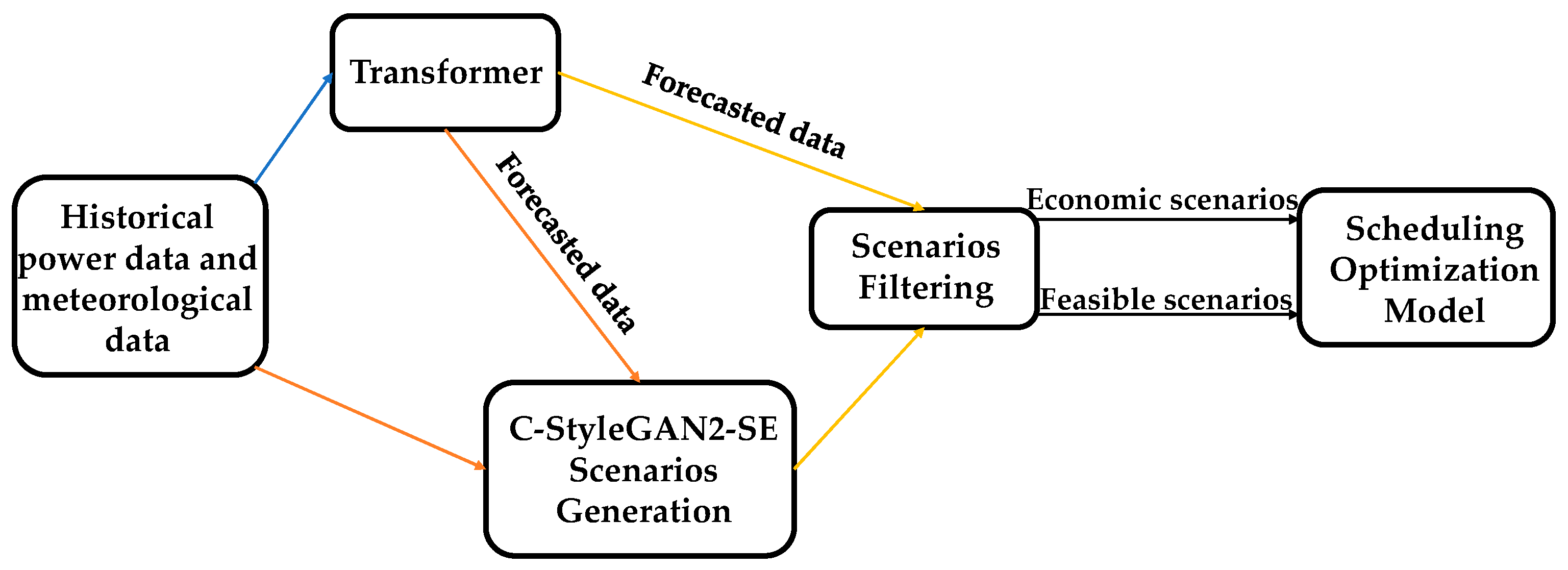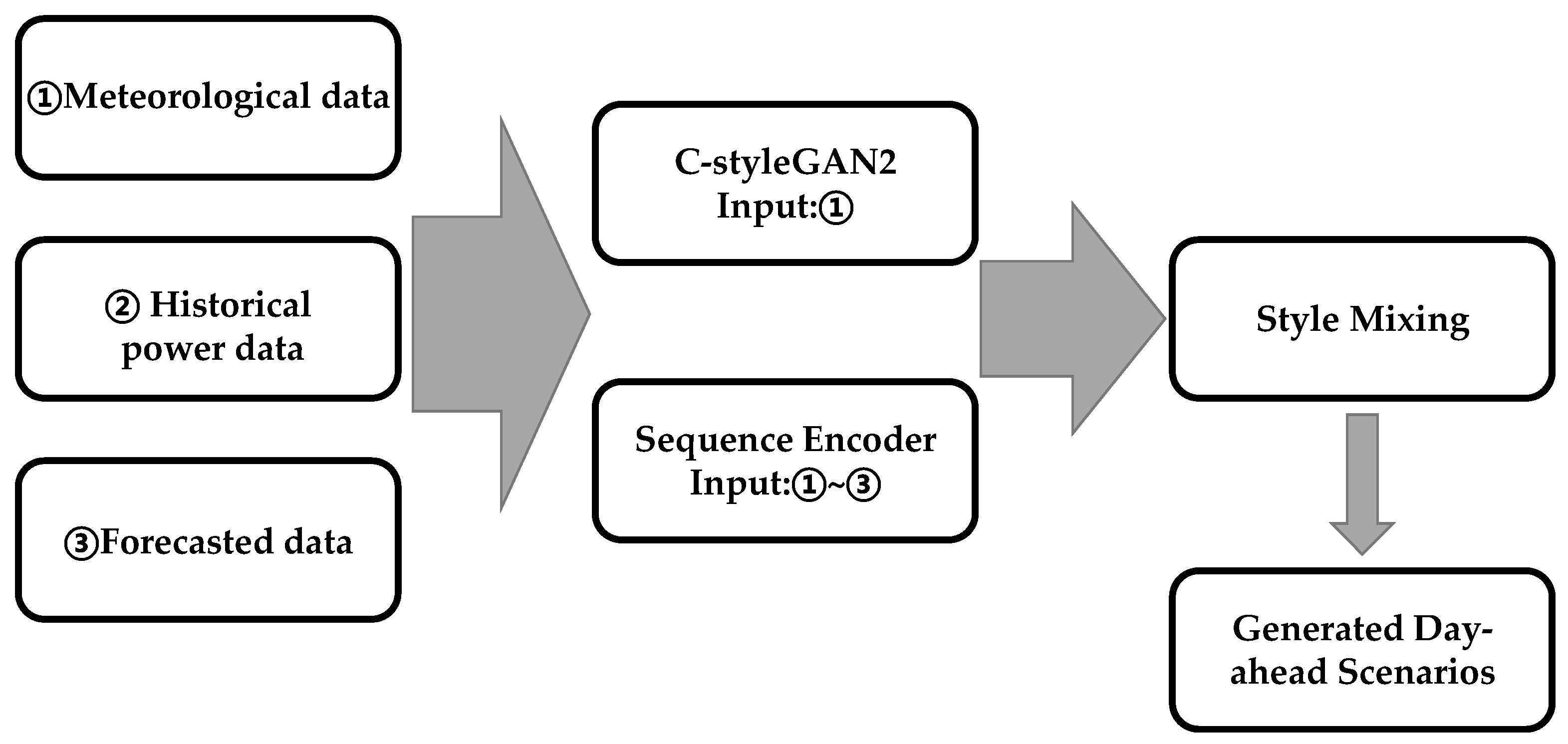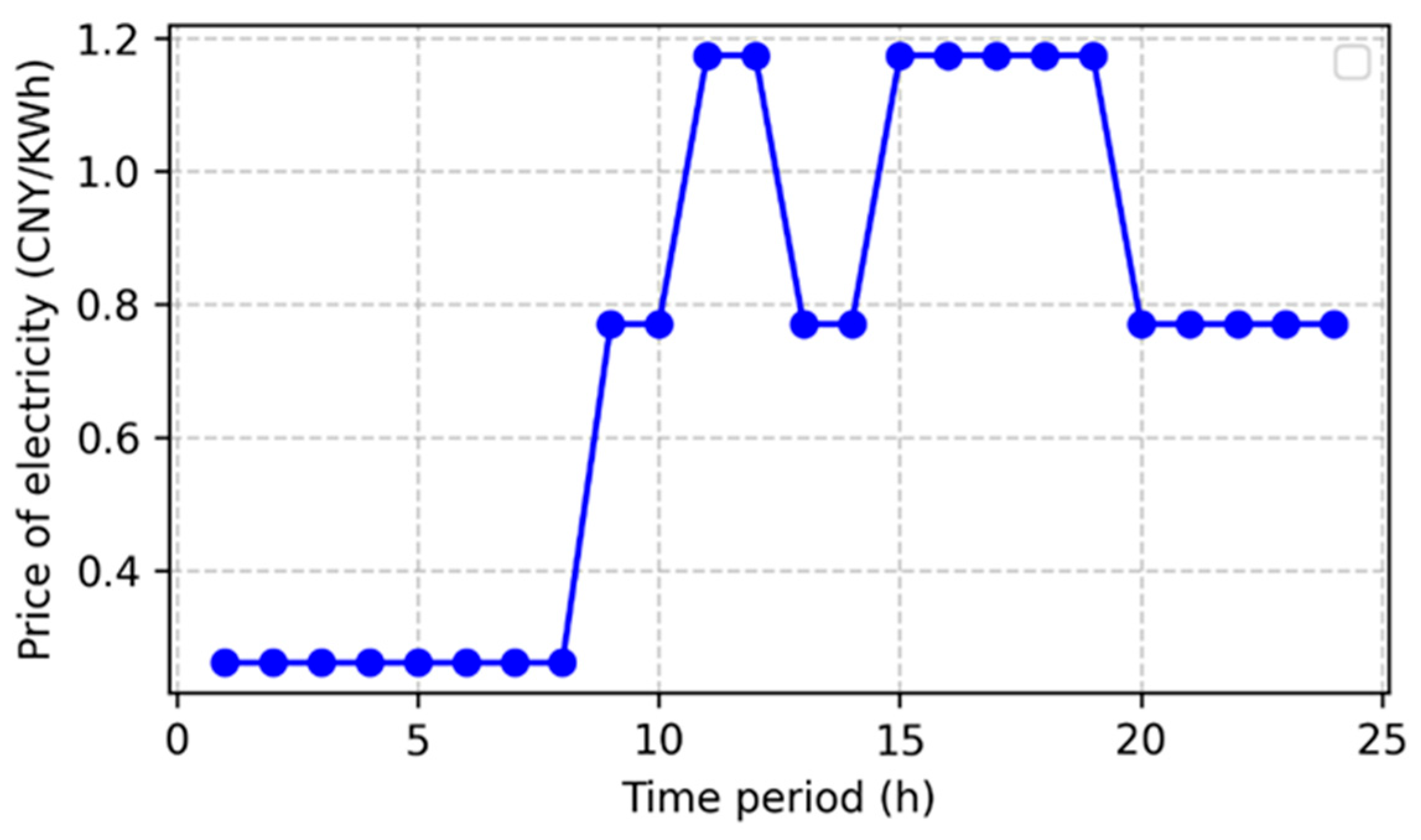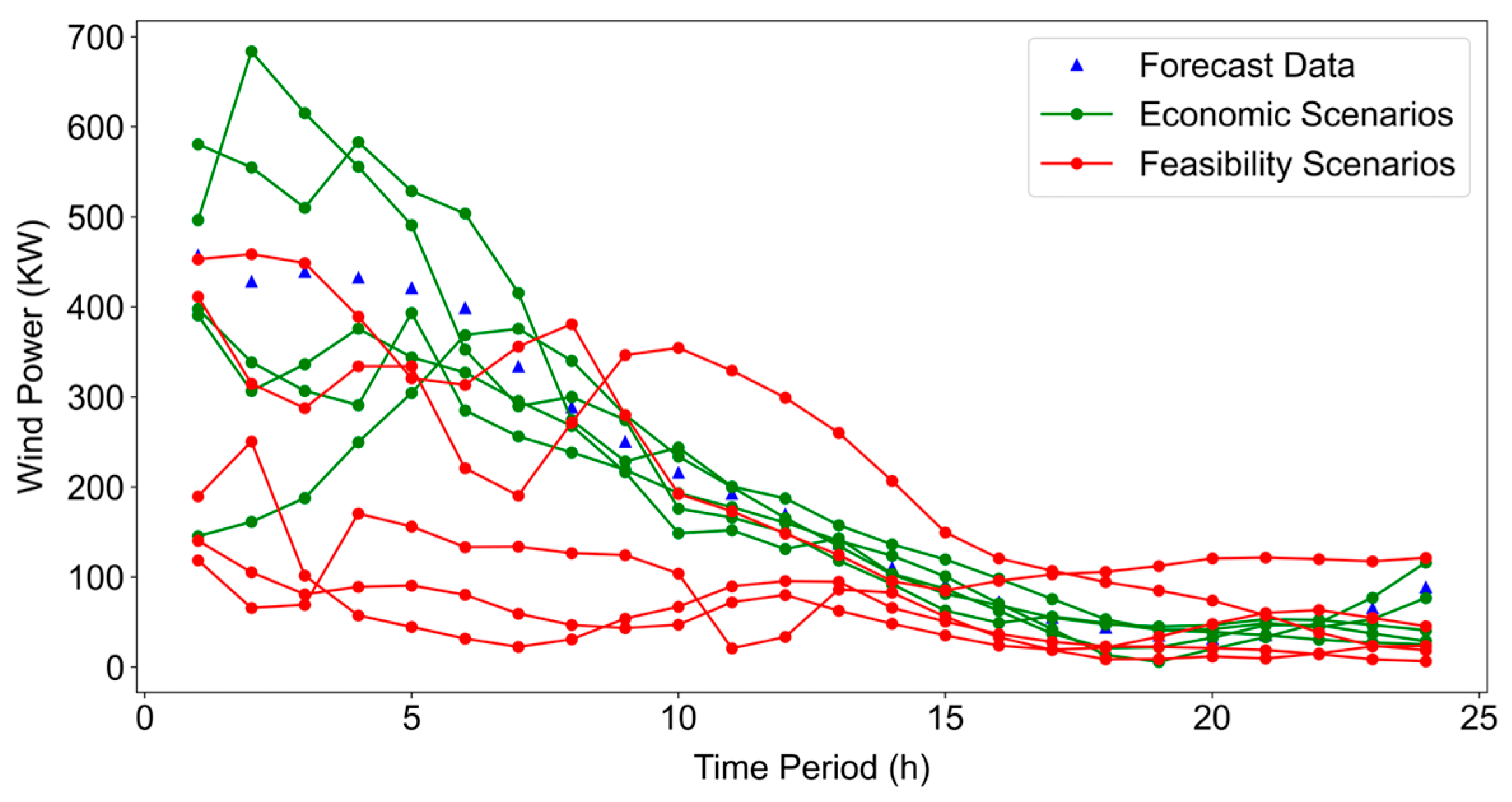A GAN-and-Transformer-Assisted Scheduling Approach for Hydrogen-Based Multi-Energy Microgrid
Abstract
1. Introduction
- (1)
- A scenario-based scheduling model for HMEMG is established with a balancing solution economy and feasibility, in which renewables, various loads, and other equipment are all formulated.
- (2)
- A GAN-based scenario generation and Transformer-assisted selection approach is proposed to obtain several economic scenarios and feasible scenarios, and avoid computational complexity caused by too many scenarios. Specifically, a C-StyleGAN2-SE model is employed to generate sufficient scenarios, and then, a Transformer architecture is applied to screen out a small number of feasible and economic scenarios.
2. Basic Scheduling Model of Hydrogen-Based Multi-Energy Microgrids
2.1. Hydrogen-Based Multi-Energy Microgrid Structure
2.2. Uncertainty of Characterization Multiple-Type Energy
2.3. Operation Model of Hydrogen-Based Multi-Energy Microgrids
2.3.1. Hydrogen
2.3.2. Heating
2.3.3. Cooling
2.3.4. Electricity
2.3.5. Objective Function
2.4. Rolling Economic Dispatch
3. GAN-and-Transform-Assisted Scenario Generation and Reduction
3.1. The Overall Framework of Method
3.2. Transformer-Based Day-Ahead Forecast Data Generation
3.3. GAN-Based Scenario Generation Technology
- (1)
- C-StyleGAN2 is trained to capture spatio-temporal dependencies of multi-energy time series under meteorological conditions; the input of this module is only meteorological Data.
- (2)
- The Sequence Encoder (SE) learns to infer the latent representation of the scheduling day from historical and forecasted data. The input of this module consists of three types of datasets: meteorological data, historical actual power data, and forecast data.
- (3)
- During scenario generation, the SE-predicted latent variables are combined with random latent variables through style mixing, ensuring both consistency with forecasts and diversity across scenarios.
3.4. MAPE-Transformer-Based Scenario Reduction Based on Forecast Deviation
4. Numerical Tests
4.1. Data Preparation
4.2. Screening Results of Economic and Feasible Scenarios
4.3. Comparisons with Other Scheduling Methods
5. Conclusions
Author Contributions
Funding
Data Availability Statement
Acknowledgments
Conflicts of Interest
Nomenclature
| Indices | |
| Index of scenarios, . | |
| Index of time periods, . | |
| Parameters | |
| , | Upper/Lower bound of electricity load (kW). |
| , | Upper/Lower bound of heating load (kW). |
| , | Upper/Lower bound of cooling load (kW). |
| , | Upper/Lower bound of wind power (kW). |
| , | Upper/Lower bound of photovoltaic power (kW). |
| , | Upper/Lower bound of hydrogen consumption rate (kg/h). |
| , | Upper/Lower bound of transfer power with the main grid (kW). |
| Hydrogen electricity generation coefficient (kWh/kg). | |
| Hydrogen heating generation coefficient (kWh/kg). | |
| , | Upper/Lower bound of discharging and charging (kWh). |
| , | Energy level of electricity ES at initial and final periods (kWh). |
| , | Upper/Lower capacity bound of ES (kWh). |
| Discharging efficiency of ES. | |
| Charging efficiency of ES. | |
| Heating efficiency of electric heating. | |
| , | Energy level of heat storage at initial and final periods (kWh). |
| , | Upper/Lower bound of heat absorption and release (kW). |
| , | Upper/Lower capacity bound of HS (kWh). |
| Refrigeration efficiency of the chiller. | |
| , | Energy level of cold storage at initial and final periods (kWh). |
| , | Upper/Lower bound of cold absorption and release (kW). |
| , | Upper/Lower capacity bound of CS (kWh). |
| , | Price of electricity (CNY/kWh) and hydrogen (CNY/kg). |
| Length of the time period (h). | |
| Mean absolute percentage error (MAPE). | |
| MAPE Upper bound of economic scenario. | |
| , | MAPE Upper/Lower bound of feasible scenario. |
| Random Variables and Decision Variables | |
| Electricity load (kW). | |
| Heating load (kW). | |
| Cooling load (kW). | |
| Wind power (kW). | |
| Photovoltaic power (kW). | |
| Exchanging power with the main grid (kW). | |
| Hydrogen consumption rate (kg/h). | |
References
- Zheng, H.Y.; Song, M.L.; Shen, Z.Y. The Evolution of Renewable Energy and Its Impact on Carbon Reduction in China. Energy 2021, 237, 121639. [Google Scholar] [CrossRef]
- Zhou, Y.; Zhai, Q.; Xu, Z.; Wu, L.; Guan, X. Multi-Stage Adaptive Stochastic-Robust Scheduling Method with Affine Decision Policies for Hydrogen-Based Multi-Energy Microgrid. IEEE Trans. Smart Grid 2024, 15, 2738–2750. [Google Scholar] [CrossRef]
- Zhou, Y.Z.; Zhai, Q.Z.; Wu, L. Optimal Operation of Regional Microgrids with Renewable and Energy Storage: Solution Robustness and Nonanticipativity Against Uncertainties. IEEE Trans. Smart Grid 2022, 13, 4218–4230. [Google Scholar] [CrossRef]
- Zhou, Y.Z.; Zhai, Q.Z.; Zhou, M.Y.; Li, X. Generation Scheduling of Self-Generation Power Plant in Enterprise Microgrid with Wind Power and Gateway Power Bound Limits. IEEE Trans. Sustain. Energy 2019, 11, 758–770. [Google Scholar] [CrossRef]
- Ou, Y.H.; Lv, L.; Liu, J.Y.; Gao, H.J. Stochastic Robust Economic Dispatch of Combined Heat and Power Microgrid Considering Renewable Energy Uncertainty. Electr. Power Constr. 2022, 43, 19–28. [Google Scholar]
- Zhao, W.; Diao, H.B.; Li, P.Q.; Lv, X.X.; Lei, E.T.; Mao, Z.Y.; Xue, W.Q. Transactive Energy-based Joint Optimization of Energy and Flexible Reserve for Integrated Electric-heat Systems. IEEE Access 2021, 9, 14491–14503. [Google Scholar] [CrossRef]
- Sang, B.; Zhang, T.; Liu, Y.J.; Liu, L.S.; Zhu, J.J.; Wang, R. Two-stage Robust Optimal Scheduling of Grid-connected Microgrid Under Expected Scenarios. IET Gener. Transm. Distrib. 2020, 40, 6161–6172. [Google Scholar]
- Zhao, Z.L.; Guo, J.T.; Luo, X.; Lai, C.S.; Yang, P.; Lai, L.L.; Li, P.; Guerrero, J.M.; Shahidehpour, M. Distributed Robust Model Predictive Control-Based Energy Management Strategy for Islanded Multi-Microgrids Considering Uncertainty. IEEE Trans. Smart Grid. 2022, 13, 2107–2120. [Google Scholar] [CrossRef]
- Chen, T.P.; Cao, Y.H.; Qing, X.L.; Zhang, J.R.; Sun, Y.H.; Amaratunga, G.A.J. Multi-energy Microgrid Robust Energy Management with a Novel Decision-Making Strategy. Energy 2022, 239, 121840. [Google Scholar] [CrossRef]
- Yang, J.; Su, C.Q. Robust Optimization of Microgrid Based on Renewable Distributed Power Generation and Load Demand Uncertainty. Energy 2021, 223, 120043. [Google Scholar] [CrossRef]
- Li, H.; Ren, Z.; Fan, M.; Li, W.; Xu, Y.; Jiang, Y.; Xia, W. A Review of Scenario Analysis Methods in Planning and Operation of Modern Power Systems: Methodologies, Applications, and Challenges. Electr. Power Syst. Res. 2022, 205, 107722. [Google Scholar] [CrossRef]
- Dong, W.; Chen, X.; Yang, Q. Data-driven Scenario Generation of Renewable Energy Production Based on Controllable Generative Adversarial Networks with Interpretability. Appl. Energy 2022, 308, 118387. [Google Scholar] [CrossRef]
- Krishna, A.B.; Abhyankar, A.R. An Efficient Data-Driven Conditional Joint Wind Power Scenario Generation for Day-Ahead Power System Operations Planning. IEEE Trans. Power Syst. 2024, 39, 3105–3117. [Google Scholar] [CrossRef]
- Morales, J.M.; Minguez, R.; Conejo, A.J. A methodology to generate statistically dependent wind speed scenarios. Appl. Energy 2010, 87, 843–855. [Google Scholar] [CrossRef]
- Yang, J.; Zhang, S.; Xiang, Y.; Liu, J.; Liu, J.; Han, X.; Teng, F. LSTM Auto-Encoder Based Representative Scenario Generation Method for Hybrid Hydro-PV Power System. IET Gener. Transmi. Distrib. 2020, 14, 5935–5943. [Google Scholar] [CrossRef]
- Qi, Y.; Hu, W.; Dong, Y.; Fan, Y.; Dong, L.; Xiao, M. Optimal configuration of concentrating solar power in multienergy power systems with an improved variational autoencoder. Appl. Energy 2020, 274, 115124. [Google Scholar] [CrossRef]
- Dumas, J.; Wehenkel, A.; Lanaspeze, D.; Cornélusse, B.; Sutera, A. A Deep Generative Model for Probabilistic Energy Forecasting in Power Systems: Normalizing Flows. Appl. Energy 2022, 305, 117871. [Google Scholar] [CrossRef]
- Chen, Y.; Wang, Y.; Kirschen, D.; Zhang, B. Model-Free Renewable Scenario Generation Using Generative Adversarial Networks. IEEE Trans. Power Syst. 2018, 33, 3265–3275. [Google Scholar] [CrossRef]
- Zhou, Y.; Han, Z.; Zhai, Q.; Wu, L.; Cao, X.; Guan, X. A Data-And-Model-Driven Acceleration Approach for Large-Scale Network-Constrained Unit Commitment Problem with Uncertainty. IEEE Trans. Sustain. Energy 2025, 1–13. [Google Scholar] [CrossRef]
- Chen, Y.; Wang, X.; Zhang, B. An unsupervised deep learning approach for scenario forecasts. In Proceedings of the 2018 Power Systems Computation Conference (PSCC), Dublin, Ireland, 11–15 June 2018. [Google Scholar]
- Liang, J.; Tang, W. Sequence Generative Adversarial Networks for Wind Power Scenario Generation. IEEE J. Sel. Areas Commun. 2020, 38, 110–118. [Google Scholar] [CrossRef]
- Yuan, R.; Wang, B.; Mao, Z.; Watada, J. Multi-Objective Wind Power Scenario Forecasting Based on PG-GAN. Energy 2021, 226, 120379. [Google Scholar] [CrossRef]
- Gao, S.; Wang, Y.; Zhou, Y.; Yu, H. An Improved Scheduling Approach for Multi-Energy Microgrids Considering Scenario Insufficiency and Computational Complexity. Processes 2025, 13, 576. [Google Scholar] [CrossRef]








| Model | Computational Efficiency | Accuracy | Consider Meteorological Data |
|---|---|---|---|
| GAN | Moderate | High | Yes |
| LSTM | Moderate | low | No |
| VAE | High | Moderate | Yes |
| Parameter | Value | Parameter | Value |
|---|---|---|---|
| , | 0, 1200 (kW) | , | 0, 200 (kW) |
| , | 0, 200 (kW) | , | 0, 1000 (kW) |
| , | 0, 500 (kW) | , | 0, 25 (kg/h) |
| , | −600, 600 (kW) | 19.09 (kWh/kg) | |
| 9.91 (kWh/kg) | , | −100, 100 (kWh) | |
| , | 150, 150 (kWh) | , | 60, 300 (kWh) |
| , | 0.9, 0.9 | , | 0.94, 0.94 |
| , | 100, 100 (kWh) | , | 40, 200 (kWh) |
| , | −50, 50 (kW) | , | 40, 200 (kWh) |
| , | 100, 100 (kWh) | 15 (CNY/kg) | |
| , | −50, 50 (kW) | 1 (h) |
| MAPE (%) | 0–10 | 10–20 | 20–30 | 30–40 | Over 40 |
|---|---|---|---|---|---|
| Proportion (%) | 41.95 | 31.75 | 13.5 | 11.3 | 1.5 |
| MAPE (%) | 0–20 | 20–40 | 40–60 | 60–80 | Over 80 |
|---|---|---|---|---|---|
| Proportion (%) | 25.15 | 41.875 | 21.175 | 10.15 | 1.7 |
| Method | Feasible Rate (%) | Cost (¥) |
|---|---|---|
| Deterministic method | 100 | 4244.035 |
| Method with only feasible scenarios | 99.2 | 4421.341 |
| Method with only economic scenarios | 69 | 4273.398 |
| The proposed method | 98.8 | 4302.192 |
Disclaimer/Publisher’s Note: The statements, opinions and data contained in all publications are solely those of the individual author(s) and contributor(s) and not of MDPI and/or the editor(s). MDPI and/or the editor(s) disclaim responsibility for any injury to people or property resulting from any ideas, methods, instructions or products referred to in the content. |
© 2025 by the authors. Licensee MDPI, Basel, Switzerland. This article is an open access article distributed under the terms and conditions of the Creative Commons Attribution (CC BY) license (https://creativecommons.org/licenses/by/4.0/).
Share and Cite
Yang, Y.; Liu, P.; Ma, H.; Tao, Z.; Tang, Z.; Zhou, Y. A GAN-and-Transformer-Assisted Scheduling Approach for Hydrogen-Based Multi-Energy Microgrid. Processes 2025, 13, 2993. https://doi.org/10.3390/pr13092993
Yang Y, Liu P, Ma H, Tao Z, Tang Z, Zhou Y. A GAN-and-Transformer-Assisted Scheduling Approach for Hydrogen-Based Multi-Energy Microgrid. Processes. 2025; 13(9):2993. https://doi.org/10.3390/pr13092993
Chicago/Turabian StyleYang, Yang, Penghui Liu, Hao Ma, Zhao Tao, Zhongxiang Tang, and Yuzhou Zhou. 2025. "A GAN-and-Transformer-Assisted Scheduling Approach for Hydrogen-Based Multi-Energy Microgrid" Processes 13, no. 9: 2993. https://doi.org/10.3390/pr13092993
APA StyleYang, Y., Liu, P., Ma, H., Tao, Z., Tang, Z., & Zhou, Y. (2025). A GAN-and-Transformer-Assisted Scheduling Approach for Hydrogen-Based Multi-Energy Microgrid. Processes, 13(9), 2993. https://doi.org/10.3390/pr13092993





